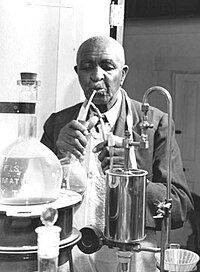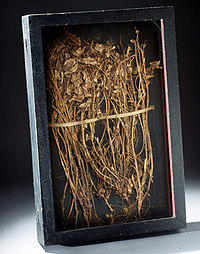George Washington Carver: Difference between revisions
revert/vandalism |
|||
| Line 3: | Line 3: | ||
==Early years== |
==Early years== |
||
Carver was born into slavery in [[Newton County, Missouri|Newton county]], Marion Township, [[Missouri]], in an area now known as [[Diamond, |
Carver was born into slavery in [[Newton County, Missouri|Newton county]], Marion Township, [[Missouri]], in an area now known as [[Diamond, Missouri]]. The exact date of birth is unknown due to the haphazard record keeping by slave owners but "it seems likely that he was born in the spring of 1865" {{ref|1}}. His owner, Moses Carver, was a [[Germany|German]] immigrant who also owned his mother, Mary, and brother. The identity of Carver's father is unknown but he believed his father was from a neighboring farm and died — shortly after Carver's birth — in a log-hauling accident {{ref|2}}. |
||
When George was an [[infant]], he and his mother were kidnapped by Confederate night raiders who hoped to sell them elsewhere, a common practice. Moses Carver hired John Bentley to find them. Carver's mother had already been sold but Carver, near death, was returned to Moses by Bentley. Moses Carver rewarded him with his best "filly." This episode caused a bout of [[Chronic obstructive pulmonary disease|respiratory disease]] that left him with a permanently weakened constitution. Because of this, he was unable to work as a hand and spent his time wandering the fields, drawn to the varieties of wild plants. He became so knowledgeable that he was known by Moses Carvers' neighbors as "the plant doctor." |
When George was an [[infant]], he and his mother were kidnapped by Confederate night raiders who hoped to sell them elsewhere, a common practice. Moses Carver hired John Bentley to find them. Carver's mother had already been sold but Carver, near death, was returned to Moses by Bentley. Moses Carver rewarded him with his best "filly." This episode caused a bout of [[Chronic obstructive pulmonary disease|respiratory disease]] that left him with a permanently weakened constitution. Because of this, he was unable to work as a hand and spent his time wandering the fields, drawn to the varieties of wild plants. He became so knowledgeable that he was known by Moses Carvers' neighbors as "the plant doctor." |
||
Revision as of 18:01, 27 October 2005
Dr. George Washington Carver (c. 1864-5 – January 5, 1943) was an African-American botanist who worked in agricultural extension in the southern United States. He taught former slaves farming techniques for self-sufficiency and is known for suggesting hundreds of uses for the peanut and other plants to increase the profitability of farming.
Early years
Carver was born into slavery in Newton county, Marion Township, Missouri, in an area now known as Diamond, Missouri. The exact date of birth is unknown due to the haphazard record keeping by slave owners but "it seems likely that he was born in the spring of 1865" [1]. His owner, Moses Carver, was a German immigrant who also owned his mother, Mary, and brother. The identity of Carver's father is unknown but he believed his father was from a neighboring farm and died — shortly after Carver's birth — in a log-hauling accident [2].
When George was an infant, he and his mother were kidnapped by Confederate night raiders who hoped to sell them elsewhere, a common practice. Moses Carver hired John Bentley to find them. Carver's mother had already been sold but Carver, near death, was returned to Moses by Bentley. Moses Carver rewarded him with his best "filly." This episode caused a bout of respiratory disease that left him with a permanently weakened constitution. Because of this, he was unable to work as a hand and spent his time wandering the fields, drawn to the varieties of wild plants. He became so knowledgeable that he was known by Moses Carvers' neighbors as "the plant doctor."
One day he was called to a neighbor's house to help with a plant in need. When he had fixed the problem, he was told to go into the kitchen to collect his reward. When he entered the kitchen, he saw no one. He did, however, see something that changed his life: beautiful paintings of flowers on the walls of the room. From that moment on, he knew that he was going to be an artist as well as a botanist.
After slavery was abolished, Moses and his wife Susan raised George and his brother Jim as their own. They encouraged Carver to continue his intellectual pursuits. Aunt Susan taught him to read some words and write his name.
He got news that there was a school for blacks in Neosho and resolved to go there at once. To his dismay, when he reached the town, the school had been closed for the night. As he had nowhere to stay, he slept in a nearby barn. By his own account, the next morning he met a kindly woman, Mariah Watkins, from whom he wished to rent a room. When he identified himself "Carver's George," as he had done his whole life, she replied that from now on, his name was "George Carver." George liked this lady very much and her words ' You must learn all you can, then go back out into the world and give your learning back to the people.' had a great impression on him.
He earned his high school diploma at Minneapolis High School in Kansas.
College years

In 1887, he was accepted to Simpson College in Indianola. He excelled in art and music, but art instructor Etta May Budd, whose father, Joseph Budd, was head of the Iowa State College Department of Horticulture, recognized Carver's horticultural talents. Realizing the difficulties facing an African-American artist, she convinced him to pursue a more pragmatic career in scientific agriculture and, in 1891, he became the first African-American to enroll at Iowa State College of Agriculture and Mechanic Arts, which today is Iowa State University.
In order to avoid confusion with another George Carver in his classes, he began to use the name George Washington Carver. Through quiet determination and perseverance, Carver soon became involved in all facets of campus life. He was a leader in the YMCA and the debate club. He worked in the dining rooms and as a trainer for the athletic teams. He was captain, the highest student rank, of the campus military regiment. His poetry was published in the student newspaper and two of his paintings were exhibited at the 1893 World's Fair in Chicago.
Carver's interests in music and art remained strong, but it was his excellence in botany and horticulture that prompted professors Joseph Budd and Louis Pammel to encourage him to stay on as a graduate student after he completed his bachelor's degree in 1894 with a thesis entitled 'Plants as modified by man'. Because of his proficiency in plant breeding, Carver was appointed to the faculty, becoming ISU's first African-American faculty member.
Over the next two years, as assistant botanist for the College Experiment Station, Carver quickly developed scientific skills in plant pathology and mycology, the branch of botany that deals with fungi. He published several articles on his work and gained national respect. He completed his master's degree in 1896.
Later years

In 1896, he was recruited to Tuskegee Normal and Industrial Institute (today: Tuskegee University) by Booker T. Washington in Tuskegee, Alabama. He remained there for 47 years until his death in 1943.
Taking an interest in the plight of poor Southern farmers working with soil depleted by repeated crops of cotton, Carver advocated employing the nitrogen cycle by alternating cotton crops with legume planting, such as peanuts, to restore nitrogen to the soil. Thus, the cotton crop was improved and new cash crops added. He developed an agricultural extension system in Alabama to train farmers in raising these crops and an industrial research laboratory to develop uses for them.
In order to make these new crops profitable, Carver devised numerous uses, several of which were unique, for the new crops, including more than 300 uses for the peanut ranging from glue to printer's ink; however, contrary to popular belief, this list does not include peanut butter. He made similar investigations into uses for plants such as sweet potatoes and pecans.
By 1920 seeing the growth of the peanut industry in USA, Chinese traders started flooding USA with oriental peanuts. In order to safegaurd their market in the country, the southern farmers came together and decided to plead their cause before a tariff hearing. Carver was elected, without hesitation, to speak before the hearing. On arrival Carver was mocked at but did not deter and began to show them the 300 uses of the peanut that he had found. Dyes, punches, varnishing cream, marble, rubbing oils, Worcestershire sauce, etc. The commitee was held spellbound and rose in applause as he went. The following year a tariff was placed on imported peanuts.
Until 1915, Carver was not widely known for his agricultural research. However he became one of the best-known African Americans of his era following the funeral of Booker T. Washington when he was praised by Theodore Roosevelt. By 1920 Carver had become reknown throughout the lands. Big business tycoons came to seek his help and he always gave it to them without a price. Three American Presidents - Theodore Roosevelt, Calvin Coolidge and Franklin Roosevelt - were acquainted with Carver. The crown prince of Sweden studied with him for three weeks. Indian leader, Gandhiji too was in his company for a while. Carver's best known guest is Henry Ford who made Carver his lab and researched there with him too. Their most notable discovery together is the fabrication of rubber.
In 1923, Carver received the Spingarn Medal by the NAACP. The NAACP awards this medal annually for outstanding achievement. In 1928, Simpson College bestowed Carver with an honorary doctorate. In 1940, Carver established the George Washington Carver Foundation at Tuskegee University. In 1941, the George Washington Carver Museum was dedicated at the Tuskegee Institute. n 1942, Carver received the Roosevelt Medal for Outstanding Contribution to Southern Agriculture.
On July 14, 1943 [3], President Franklin Delano Roosevelt dedicated $30,000 for the national monument west-south-west of Diamond, Missouri of the area of his childhood as a park. This dedication marks the first national monument dedicated to an African-American. At this 210 acre national monument, there is a bust of Carver, a 3/4 mile nature trail, a museum, the Moses Carver house, and the Carver cemetery.
Death and afterwards
Upon returning home one day, Carver took a bad fall down a flight of stairs; he was found unconscious by a maid who took him to a hospital. Carver died January 5, 1943 at the age of 79 from complications (anemia) resulting from this fall.
On his grave was written the simplest and most meaningful summary of his life. 'He could have added fortune to fame, but caring for none, he found happiness and honour in being helpful to the world'
Carver appeared on US commemorative stamps in 1947 and 1998 and was depicted on a commemorative half-dollar in 1953. The USS George Washington Carver (SSBN-656) is also named in his honor.
In 1977, Carver was elected to the Hall of Fame for Great Americans. In 1990, Carver was inducted into the National Inventors Hall of Fame. Iowa State University awarded Carver the Doctor of Humane Letters in 1994. On February 15, 2005, an episode of Modern Marvels included scenes from within Iowa State University's Food Sciences Building and about Carver's work.
See also
Reference
- McMurry, L. O. Carver, George Washington. American National Biography Online Feb. 2000
- ^ Pages 9-10 of George Washington Carver: Scientist and Symbol by Linda McMurray, 1982. (ISBN 0195032055)
- ^ Page 10 of George Washington Carver: Scientist and Symbol by Linda McMurray, 1982. (ISBN 0195032055)
- ^ http://www.nps.gov/gwca/index.htm
